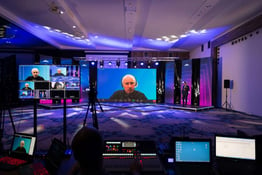7 Things to Know About Making a Virtual Exhibition Booth
Virtual exhibition booths can be just as effective as the real thing at an on-site conference. You...

2020 was a big year for virtual event production. Employees were working remotely in many organizations, so business teams had to quickly learn how to plan virtual events to engage their dispersed teams. Over time, many firms became well-grounded in the best practices necessary for successful virtual event production. But work environments are changing again even as COVID-19 becomes less of a concern.
2021 will likely be the year of hybrid event production for many companies. As businesses begin to reopen in 2021, we will see more virtual and hybrid events, combining the best of the online experience with on-site meetings. What do companies need when planning these types of events?
A virtual event is an online meet up that uses digital technologies to bring people together. It could be an educational event, a corporate meeting, or some other type of gathering where people dial in but never physically go to a specific physical location.
There’s an element of virtual event production in every hybrid event, because they incorporate a mix of live audiences with a speaker but broadcast it to online participants. To put it another way, hybrid event production uses elements of the digital space along with a live physical event. What are the benefits of combining all of these meeting techniques into one forum?
The biggest benefit of virtual events is that participants don’t have to travel to a meeting location. This extends the reach of the meeting or event while also cutting costs. We believe there is a misconception that having both a live and a virtual event will split your primary audience. Actually, the opposite is true: You can expand your reach and add more participants who never would have attended an onsite event. One study found that 98% of hybrid event attendees were not planning on going to the live meeting. Another study showed 23% of hybrid event organizers said their virtual attendees came back for more online future events—but never attended in person.
Every event planner knows that people learn in different ways. That’s why combining virtual and hybrid events is so intriguing. There are more opportunities for audience engagement during a hybrid live and virtual event. Your virtual audience can chat, share emojis, comment, and more, while the live audience is networking, listening, clapping, and asking questions. When the live speaker asks for a show of hands, you can conduct a virtual poll so that everyone’s voices are heard. You could have a breakout session where live attendees use their phones to interact in a video conference with online participants.
Just as there are more audience participation channels in hybrid event production, there are also more sponsorship opportunities. One study showed 72% of corporate sponsors are interested in hybrid event participation. These sponsors understand that a hybrid event reaches more of their target audience. There are also more sponsorship opportunities for their brand, whether it’s sponsoring a virtual networking session or a live onsite lunch. That flexibility can be designed around any budget, which can increase the diversity of sponsorships to help meet your event-related revenue goals more quickly.
Audience engagement is the most important element of virtual and hybrid events. Engagement is critical to any event, but particularly so in hybrid event production or virtual event production. The idea is that your audience won’t watch from a TV, but will instead dial in from their favorite digital device. This makes entertaining your audience multi-faceted. Your goal is two-fold: Engage your live audience while also engaging your virtual participants.
A hybrid event should seamlessly integrate of all the benefits of a live and virtual event. That makes engagement more challenging because you have more channels to reach and collaborate with your audience. It is the audience itself that makes for a successful event, whether it’s virtual or hybrid. Making sure their journey is a positive reflection of your company is essential. This is harder in hybrid event production, because you will have to design an experience for the live audience that will be different from the virtual attendee experience. However, the goal of every attendee, no matter where they are participating from, is likely:
To ensure that you’ve given attendees what they want from your virtual or hybrid event, you will need to plan well, engage your audiences, and build your brand. What will you need to prepare for your hybrid or virtual event production?
If you’re designing your hybrid event from the perspective of your audience, which is a recommended best practice, there are three things you’ll need to ensure your success:
The biggest trick with an agenda for a hybrid event production is how you deliver the content. There are always going to be two tracks: the live audience and the virtual audience. This makes a hybrid event more complex in how you design and deliver the agenda.
We know networking or virtual and live audience collaboration will be a key goal for any attendee. In hybrid event production, you should plan for physical breakout sessions as well as virtual chat and video conference rooms. Make sure your virtual attendees are not segregated from the live audience. Organize simultaneous tracks to give your attendees a more engaging experience.
Use these virtual engagement tools, not only for your online attendees, but also for your live audience. Set up online registration for all attendees and then use that tool to engage your live and online audience with polls and Q&A features. Remember that most (if not all) of your live attendees will have a smartphone, so you can engage them digitally. Virtual attendees can contribute to the successful live event by offering real-time comments, answering polls, and asking live presenters questions.
The point is that you have a seamless two-way flow with live attendees engaging digitally and online audiences participating in the on-site event. That’s the real power of a hybrid event.
Now that you’re excited about hybrid event production and the possibilities, you should know that having the right third-party vendor for your virtual event is critical to your success. Onstream Media has been helping companies like yours engage their audiences with virtual and hybrid events since 1993. We’ve been at the forefront of the evolution of meetings, and we’d like to share our expertise with your company. If you’re wondering how to plan a virtual event, we can help. Contact us to find out more.

Virtual exhibition booths can be just as effective as the real thing at an on-site conference. You...

2020 taught us a lot about the power of the internet. That was the year nearly 90% of product...